The Evolution of Smart City Policy in China: A Quantitative Study Based on the Content of Policy Texts
Abstract
:1. Introduction
2. Methodology
2.1. Analytical Framework
2.2. Data Acquisition and Preprocessing
2.2.1. Policy Sample Selection
2.2.2. Policy Sample Code
2.3. Model Construction and Data Analysis
2.3.1. Quantitative Analysis of Policy Content
2.3.2. Calculation of Policy Effectiveness Values
2.3.3. Social Network Analysis
2.4. Depth Analysis, Results Analysis, and Discussion
3. Quantitative Analysis of Policy Texts
3.1. Policy Content Analysis
3.1.1. Policy Object
3.1.2. Policy Tools
3.1.3. Cross-Analysis of Policy Objects and Policy Tools
3.2. Policy Organization Structure
3.2.1. Type of Publication
3.2.2. Totality Policy Organization Structure
3.3. Analysis of Policy Effectiveness
4. Analysis of Policy Evolution Stage
4.1. 2012–2014 Was a Period of Exploration
4.2. 2015–2018 Is the Period of Development
4.3. 2019-Present Is a Period of Enhancement
5. Conclusion and Discussion
5.1. Lessons Learned from Previous Policies
- (1)
- The policy content, organizational structure, and policy effectiveness are unified under the framework of policy evolution theory, which realizes the mutual confirmation of qualitative public policy analysis and quantitative policy text research and supports the empirical judgment of the evolutionary process of a smart city policy.
- (2)
- Different policy instrument classifications reflect policymakers’ perceptions of smart cities. Based on the cognitive logic of construction, this study proposes a two-dimensional matrix classification of smart city policy tools and policy objects (objectives). The in-depth dialogues between policy objects and policy tools and policy tools and policy subjects help influence and guide the continuous improvement of policymakers, ideas, and thinking.
- (3)
- Overall, the policymaking of smart cities at the central level tends to be environment- and supply-oriented. This aspect includes the use of policy tools, especially supply-oriented policy tools. The central government is more inclined to adopt the strategy of the direct expansion of the supply and indirect impacts to accelerate the pace of smart city construction. However, demand-oriented policy tools have not been given sufficient attention, and the overflow, shortages, or lack of tools have different degrees. In the smart city construction process in the future, we should make more active use of the catalyst of urban policy and give full play to its role in guiding and regulating the construction of smart cities to implement smart city policy and promote the policy effect better.
5.2. Suggestions for Future Policies
5.2.1. Emphasizing the Importance of the Citizen’s Position in the Development of Smart Cities
5.2.2. Improve Citizens’ Sense of Participation in the Construction of Smart Cities
5.2.3. Promote the Development of Smart Cities from Fragmentation to Systemic Development
5.2.4. Improving the Level of Information Technology and Attracting Outstanding Talents
5.2.5. Improve Relevant Information Disclosure and Privacy Safeguards to Increase the Level of Public Trust in the Government
5.2.6. Promote the Establishment of the “User Perspective” of the Smart City Construction Practice and Improve Public Access and Satisfaction
5.3. Limitations of This Work
Author Contributions
Funding
Data Availability Statement
Conflicts of Interest
References
- Bibri, S.E.; Krogstie, J. Smart sustainable cities of the future: An extensive interdisciplinary literature review. Sustain. Cities Soc. 2017, 31, 183–212. [Google Scholar] [CrossRef]
- Brown, I.; Kellenberg, S. Ecologically Engineering Cities Through Integrated Sustainable Systems Planning. J. Green Build. 2009, 4, 58–75. [Google Scholar] [CrossRef]
- Pan, J.; Deng, Y.; Yang, Y.; Zhang, Y. Location-allocation modelling for rational health planning: Applying a two-step optimization approach to evaluate the spatial accessibility improvement of newly added tertiary hospitals in a metropolitan city of China. Soc. Sci. Med. 2023, 338, 116296. [Google Scholar] [CrossRef] [PubMed]
- Neves, F.T.; Neto, M.d.C.; Aparicio, M. The impacts of open data initiatives on smart cities: A framework for evaluation and monitoring. Cities 2020, 106, 102860. [Google Scholar] [CrossRef]
- Yue, A.; Mao, C.; Wang, Z.; Peng, W.; Zhao, S. Finding the pioneers of China’s smart cities: From the perspective of construction efficiency and construction performance. Technol. Forecast. Soc. Chang. 2024, 204, 123410. [Google Scholar] [CrossRef]
- Wen, L.; Kenworthy, J.; Marinova, D. Higher Density Environments and the Critical Role of City Streets as Public Open Spaces. Sustainability 2020, 12, 8896. [Google Scholar] [CrossRef]
- Conrow, L.; Mooney, S.; Wentz, E.A. The association between residential housing prices, bicycle infrastructure and ridership volumes. Urban Stud. 2021, 58, 787–808. [Google Scholar] [CrossRef]
- Klos, M.J.; Sierpinski, G. Building a Model of Integration of Urban Sharing and Public Transport Services. Sustainability 2021, 13, 3086. [Google Scholar] [CrossRef]
- Cheng, R.; Li, W. Evaluating environmental sustainability of an urban industrial plan under the three-line environmental governance policy in China. J. Environ. Manag. 2019, 251, 109545. [Google Scholar] [CrossRef]
- Ismagilova, E.; Hughes, L.; Rana, N.P.; Dwivedi, Y.K. Security, Privacy and Risks Within Smart Cities: Literature Review and Development of a Smart City Interaction Framework. Inf. Syst. Front. 2022, 24, 393–414. [Google Scholar] [CrossRef]
- Madakam, S.; Ramaswamy, R. Smart Cities Meixi (China) x Kochi (India) Notions (Sustainable Management Action Resource Tools for Cities). In Advanced Computing and Communication Technologies, Proceedings of the 9th International Conference on Advanced Computing and Communication Technologies (ICACCT), New Delhi, India, 28–29 November 2015; Asia Pacific Institute of Information Technology: Panipat, India, 2016; pp. 269–277. [Google Scholar]
- Sun, Q.; Luo, W.; Dong, X.Z.; Lei, S.H.; Mu, M.; Zeng, S. Landsat observations of total suspended solids concentrations in the Pearl River Estuary, China, over the past 36 years. Environ. Res. 2024, 249, 118461. [Google Scholar] [CrossRef] [PubMed]
- Han, M.J.N.; Kim, M.J. A critical review of the smart city in relation to citizen adoption towards sustainable smart living. Habitat Int. 2021, 108, 102312. [Google Scholar] [CrossRef]
- Kumar, D. ‘Smart cities’ and citizenship. Int. J. Hum. Rights Const. Stud. 2022, 9, 272–281. [Google Scholar] [CrossRef]
- Zubizarreta, I.; Seravalli, A.; Arrizabalaga, S. Smart City Concept: What It Is and What It Should Be. J. Urban Plan. Dev. 2016, 142, 04015005. [Google Scholar] [CrossRef]
- Li, T.; Xin, S.; Xi, Y.; Tarkoma, S.; Hui, P.; Li, Y. Predicting Multi-level Socioeconomic Indicators from Structural Urban Imagery. In Proceedings of the 31st ACM International Conference on Information and Knowledge Management (CIKM), Atlanta, GA, USA, 17–21 October 2022; pp. 3282–3291. [Google Scholar]
- Marchetti, D.; Oliveira, R.; Figueira, A.R. Are global north smart city models capable to assess Latin American cities? A model and indicators for a new context. Cities 2019, 92, 197–207. [Google Scholar] [CrossRef]
- Bibri, S.E. Compact urbanism and the synergic potential of its integration with data-driven smart urbanism: An extensive interdisciplinary literature review. Land Use Policy 2020, 97, 104703. [Google Scholar] [CrossRef]
- Yue, A.B.; Mao, C.; Chen, L.Y.; Liu, Z.B.; Zhang, C.J.; Li, Z.Q.; Li, Z.A. Detecting Changes in Perceptions towards Smart City on Chinese Social Media: A Text Mining and Sentiment Analysis. Buildings 2022, 12, 1182. [Google Scholar] [CrossRef]
- Jiang, H.; Jiang, P.; Wang, D.; Wu, J. Can smart city construction facilitate green total factor productivity? A quasi-natural experiment based on China’s pilot smart city. Sustain. Cities Soc. 2021, 69, 102809. [Google Scholar] [CrossRef]
- Nahiduzzaman, K.M.; Holland, M.; Sikder, S.K.; Shaw, P.; Hewage, K.; Sadiq, R. Urban Transformation Toward a Smart City: An E-Commerce-Induced Path-Dependent Analysis. J. Urban Plan. Dev. 2021, 147, 04020060. [Google Scholar] [CrossRef]
- Chatfield, A.T.; Reddick, C.G. Smart City Implementation Through Shared Vision of Social Innovation for Environmental Sustainability: A Case Study of Kitakyushu, Japan. Soc. Sci. Comput. Rev. 2016, 34, 757–773. [Google Scholar] [CrossRef]
- Butters, C.; Cheshmehzangi, A.; Sassi, P. Cities, energy and climate: Seven reasons to question the dense high-rise city. J. Green Build. 2020, 15, 197–214. [Google Scholar] [CrossRef]
- Rong, Y.C.; Xu, Z.M.; Liu, J.; Liu, H.; Ding, J.; Liu, X.Y.; Luo, W.; Zhang, C.M.; Gao, J.X. Du-Bus: A Realtime Bus Waiting Time Estimation System Based On Multi-Source Data. IEEE Trans. Intell. Transp. Syst. 2022, 23, 24524–24539. [Google Scholar] [CrossRef]
- Das, D. In pursuit of being smart? A critical analysis of India’s smart cities endeavor. Urban Geogr. 2020, 41, 55–78. [Google Scholar] [CrossRef]
- Yigitcanlar, T.; Degirmenci, K.; Butler, L.; Desouza, K.C. What are the key factors affecting smart city transformation readiness? Evidence from Australian cities. Cities 2022, 120, 103434. [Google Scholar] [CrossRef]
- Ye, K.; Guo, Z.; Zhang, W.; Liang, Y. Heterogeneous environmental policy tools for expressway construction projects: A crossregional analysis in China. Environ. Impact Assess. Rev. 2022, 97, 106907. [Google Scholar] [CrossRef]
- Jiang, L.; Lai, Y.; Guo, R.; Li, X.; Hong, W.; Tang, X. Measuring the impact of government intervention on the spatial variation of market-oriented urban redevelopment activities in Shenzhen, China. Cities 2024, 147, 104834. [Google Scholar] [CrossRef]
- Zhu, S.Y.; Li, D.Z.; Feng, H.B. Is smart city resilient? Evidence from China. Sustain. Cities Soc. 2019, 50, 101636. [Google Scholar] [CrossRef]
- Zhou, Q.; Zhu, M.K.; Qiao, Y.R.; Zhang, X.L.; Chen, J. Achieving resilience through smart cities? Evidence from China. Habitat Int. 2021, 111, 102348. [Google Scholar] [CrossRef]
- Kummitha, R.K.R.; Crutzen, N. How do we understand smart cities? An evolutionary perspective. Cities 2017, 67, 43–52. [Google Scholar] [CrossRef]
- Borsekova, K.; Korony, S.; Vanova, A.; Vitalisova, K. Functionality between the size and indicators of smart cities: A research challenge with policy implications. Cities 2018, 78, 17–26. [Google Scholar] [CrossRef]
- Ocampo, L.; Angela Ebisa, J.; Ombe, J.; Geen Escoto, M. Sustainable ecotourism indicators with fuzzy Delphi method A Philippine perspective. Ecol. Indic. 2018, 93, 874–888. [Google Scholar] [CrossRef]
- Kong, Y.; Feng, C.; Yang, J. How does China manage its energy market? A perspective of policy evolution. Energy Policy 2020, 147, 111898. [Google Scholar] [CrossRef]
- Yu, J.; Zhang, L. Evolution of marine ranching policies in China: Review, performance and prospects. Sci. Total Environ. 2020, 737, 139782. [Google Scholar] [CrossRef] [PubMed]
- Teddlie, C.; Tashakkori, A. Common “Core” Characteristics of Mixed Methods Research: A Review of Critical Issues and Call for Greater Convergence. Am. Behav. Sci. 2012, 56, 774–788. [Google Scholar] [CrossRef]
- Miles, M.B.; Huberman, A.M. Qualitative data-analysis—An expanded sourcebook. J. Environ. Psychol. 1994, 14, 336–337. [Google Scholar]
- Zhao, X.; Thomas, C.W.; Cai, T. The Evolution of Policy Instruments for Air Pollution Control in China: A Content Analysis of Policy Documents from 1973 to 2016. Environ. Manag. 2020, 66, 953–965. [Google Scholar] [CrossRef]
- Yin, Y.; Ma, H.; Wu, Z.; Yue, A. How Does China Build Its Fintech Strategy? A Perspective of Policy Evolution. Sustainability 2023, 15, 10100. [Google Scholar] [CrossRef]
- Kalantari, E.; Montazer, G.; Ghazinoory, S. Mapping of a science and technology policy network based on social network analysis. J. Entrep. Manag. Innov. 2021, 17, 115–147. [Google Scholar] [CrossRef]
- Roy, R.; Walter, Z. An assessment of government innovation policies. Rev. Policy Res. 1984, 3, 9. [Google Scholar]
- Li, L.; Zheng, Y.; Zheng, S.; Ke, H. The new smart city programme: Evaluating the effect of the internet of energy on air quality in China. Sci. Total Environ. 2020, 714, 136380. [Google Scholar] [CrossRef]
- Svecova, H. Design of a Method for Setting IoT Security Standards in Smart Cities. In Proceedings of the 18th International Conference on Mobile Web and Intelligent Information Systems (MobiWIS), Rome, Italy, 22–24 August 2022; pp. 118–128. [Google Scholar]
- Chang, V.; Wang, Y.; Wills, G. Research investigations on the use or non-use of hearing aids in the smart cities. Technol. Forecast. Soc. Chang. 2020, 153, 119231. [Google Scholar] [CrossRef]
- Levenda, A.M.; Keough, N.; Rock, M.; Miller, B. Rethinking public participation in the smart city. Can. Geogr. -Geogr. Can. 2020, 64, 344–358. [Google Scholar] [CrossRef]
- Mao, C.; Yue, A. Research on the Quantification and Evolution of Smart City Policy Texts under the Paradigm of Policy Science. J. Intell. 2021, 40, 7. [Google Scholar]
- Flanagan, K.; Uyarra, E.; Laranja, M. Reconceptualising the ‘policy mix’ for innovation. Res. Policy 2011, 40, 702–713. [Google Scholar] [CrossRef]
- Libecap, G.D. Economic variables and law development: A case of western mineral property. J. Econ. Hist. 1978, 38, 338–362. [Google Scholar] [CrossRef]
- Bertoldi, P.; Mosconi, R. Do energy efficiency policies save energy? A new approach based on energy policy indicators (in the EU Member States). Energy Policy 2020, 139, 111320. [Google Scholar] [CrossRef]
- Hu, R. The State of Smart Cities in China: The Case of Shenzhen. Energies 2019, 12, 4375. [Google Scholar] [CrossRef]
- Browne, N.J.W. Regarding Smart Cities in China, the North and Emerging Economies-One Size Does Not Fit All. Smart Cities 2020, 3, 186–201. [Google Scholar] [CrossRef]
- Mondschein, J.; Clark-Ginsberg, A.; Kuehn, A. Smart cities as large technological systems: Overcoming organizational challenges in smart cities through collective action. Sustain. Cities Soc. 2021, 67, 102730. [Google Scholar] [CrossRef]
- Peng, G.C.A.; Nunes, M.B.; Zheng, L. Impacts of low citizen awareness and usage in smart city services: The case of London’s smart parking system. Inf. Syst. E-Bus. Manag. 2017, 15, 845–876. [Google Scholar] [CrossRef]
- Chakravarty, S.; Bin Mansoor, M.S.; Kumar, B.; Seetharaman, P. Challenges of consultant-led planning in India’s smart cities mission. Environ. Plan. B-Urban Anal. City Sci. 2022, 50, 1375–1393. [Google Scholar] [CrossRef]
- Arku, R.N.; Buttazzoni, A.; Agyapon-Ntra, K.; Bandauko, E. Highlighting smart city mirages in public perceptions: A Twitter sentiment analysis of four African smart city projects. Cities 2022, 130, 103857. [Google Scholar] [CrossRef]
- Sepasgozar, S.M.E.; Hawken, S.; Sargolzaei, S.; Foroozanfa, M. Implementing citizen centric technology in developing smart cities: A model for predicting the acceptance of urban technologies. Technol. Forecast. Soc. Chang. 2019, 142, 105–116. [Google Scholar] [CrossRef]
- Yigitcanlar, T.; Kankanamge, N.; Vella, K. How Are Smart City Concepts and Technologies Perceived and Utilized? A Systematic Geo-Twitter Analysis of Smart Cities in Australia. J. Urban Technol. 2021, 28, 135–154. [Google Scholar] [CrossRef]
- Yigitcanlar, T.; Kamruzzaman, M.; Buys, L.; Ioppolo, G.; Sabatini-Marques, J.; da Costa, E.M.; Yun, J.J. Understanding ‘smart cities’: Intertwining development drivers with desired outcomes in a multidimensional framework. Cities 2018, 81, 145–160. [Google Scholar] [CrossRef]
- Laurini, R. A primer of knowledge management for smart city governance. Land Use Policy 2021, 111, 104832. [Google Scholar] [CrossRef]
- Sweeting, D.; de Alba-Ulloa, J.; Pansera, M.; Marsh, A. Easier said than done? Involving citizens in the smart city. Environ. Plan. C-Politics Space 2022, 40, 1365–1381. [Google Scholar] [CrossRef]
- Shelton, T.; Zook, M.; Wiig, A. The ‘actually existing smart city’. Camb. J. Reg. Econ. Soc. 2015, 8, 13–25. [Google Scholar] [CrossRef]
- Mao, C.; Wang, Z.; Yue, A.; Liu, H.; Peng, W. Evaluation of smart city construction efficiency based on multivariate data fusion: A perspective from China. Ecol. Indic. 2023, 154, 110882. [Google Scholar] [CrossRef]
- Li, B.; Li, G.; Luo, J. Latent but not absent: The ‘long tail’ nature of rural special education and its dynamic correction mechanism. PLoS ONE 2021, 16, e0242023. [Google Scholar] [CrossRef]

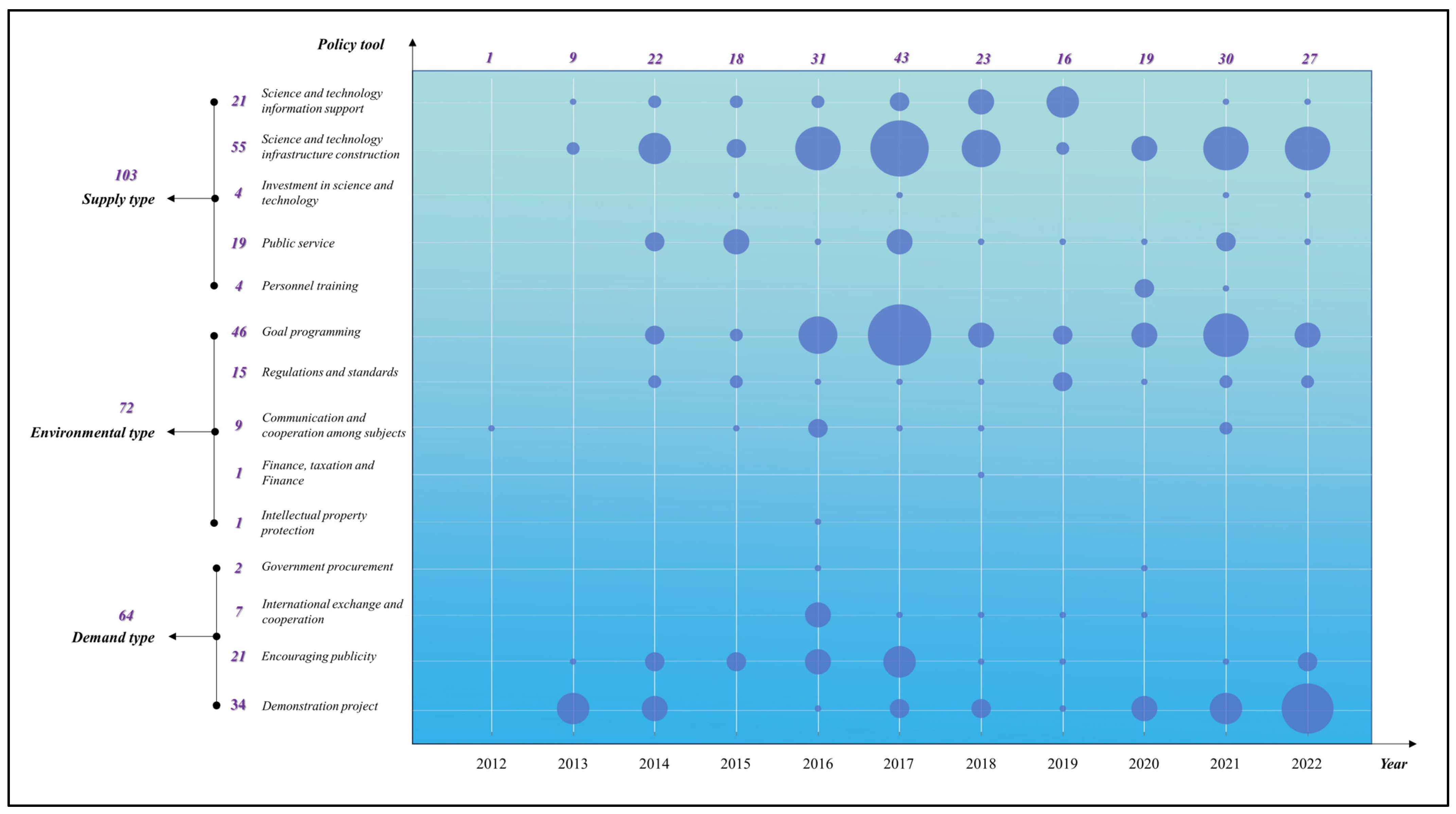
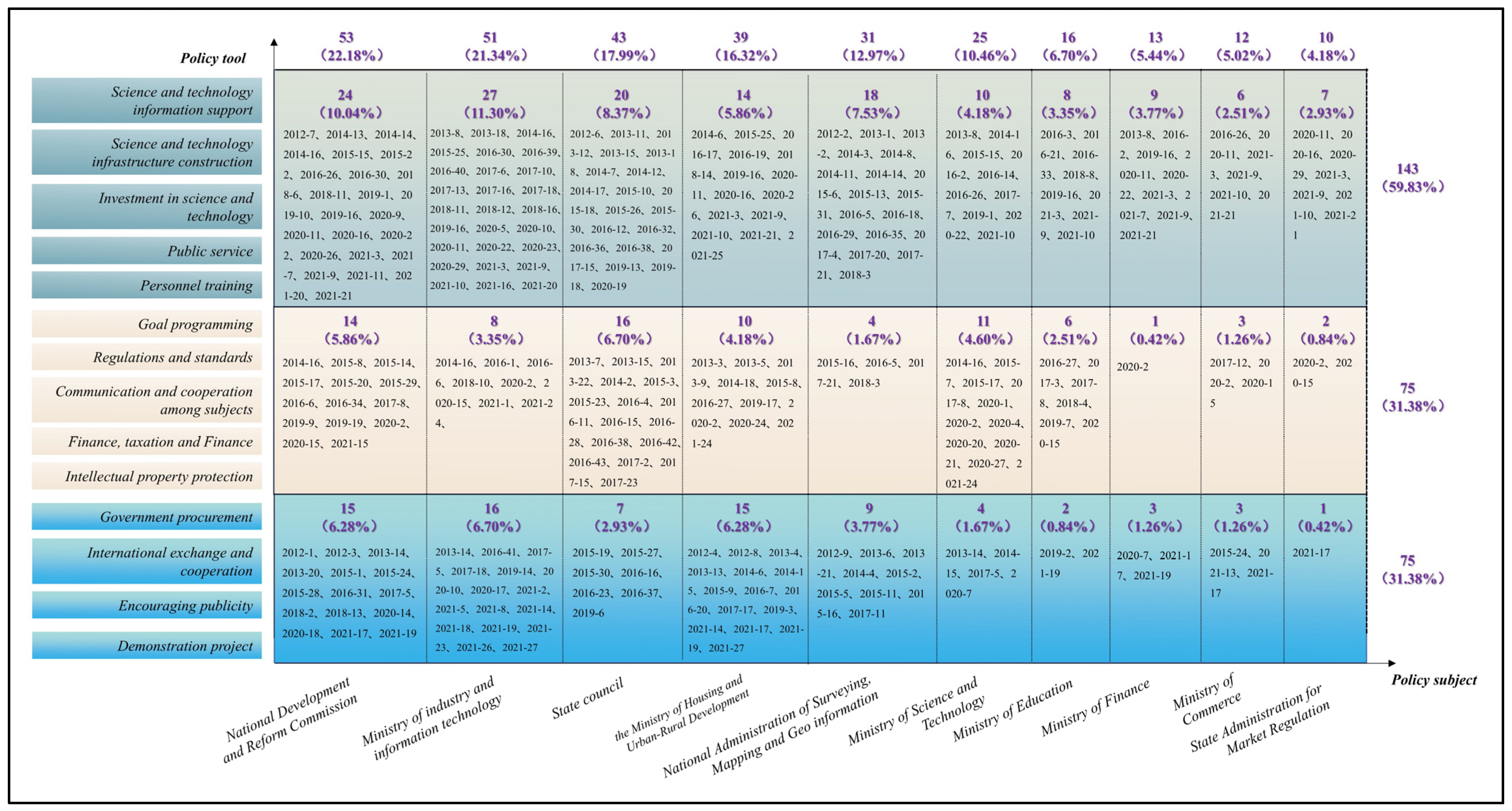
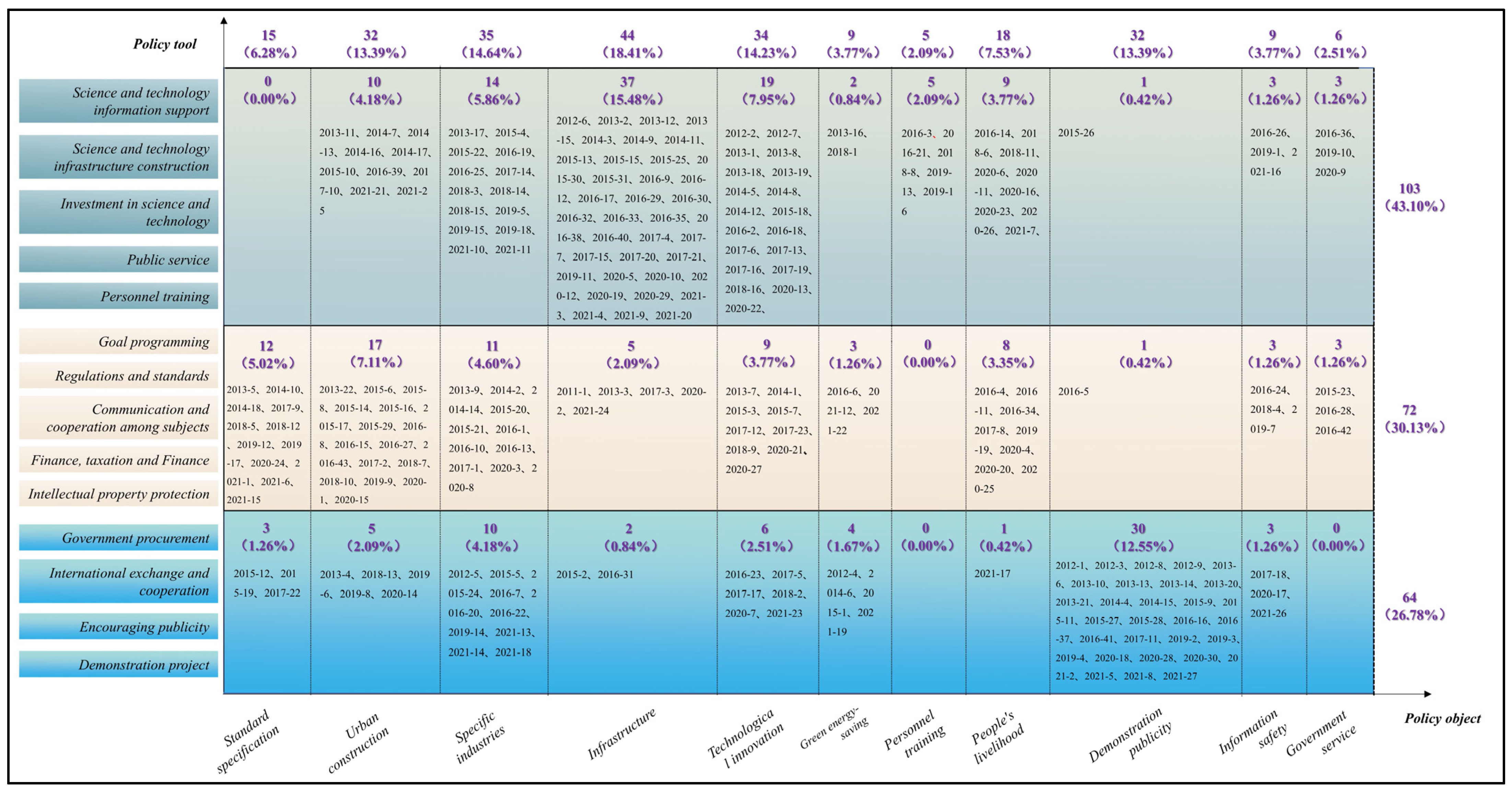

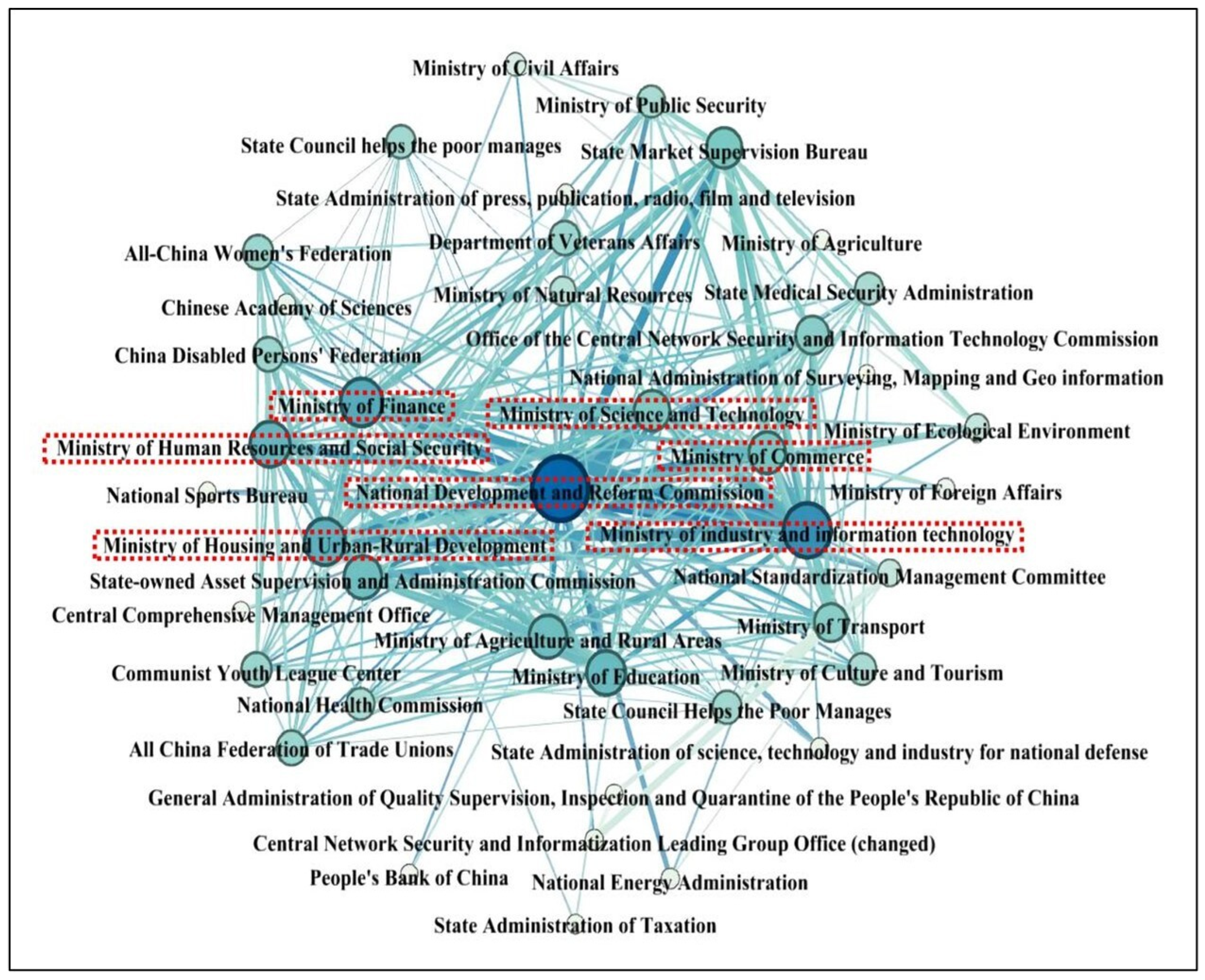
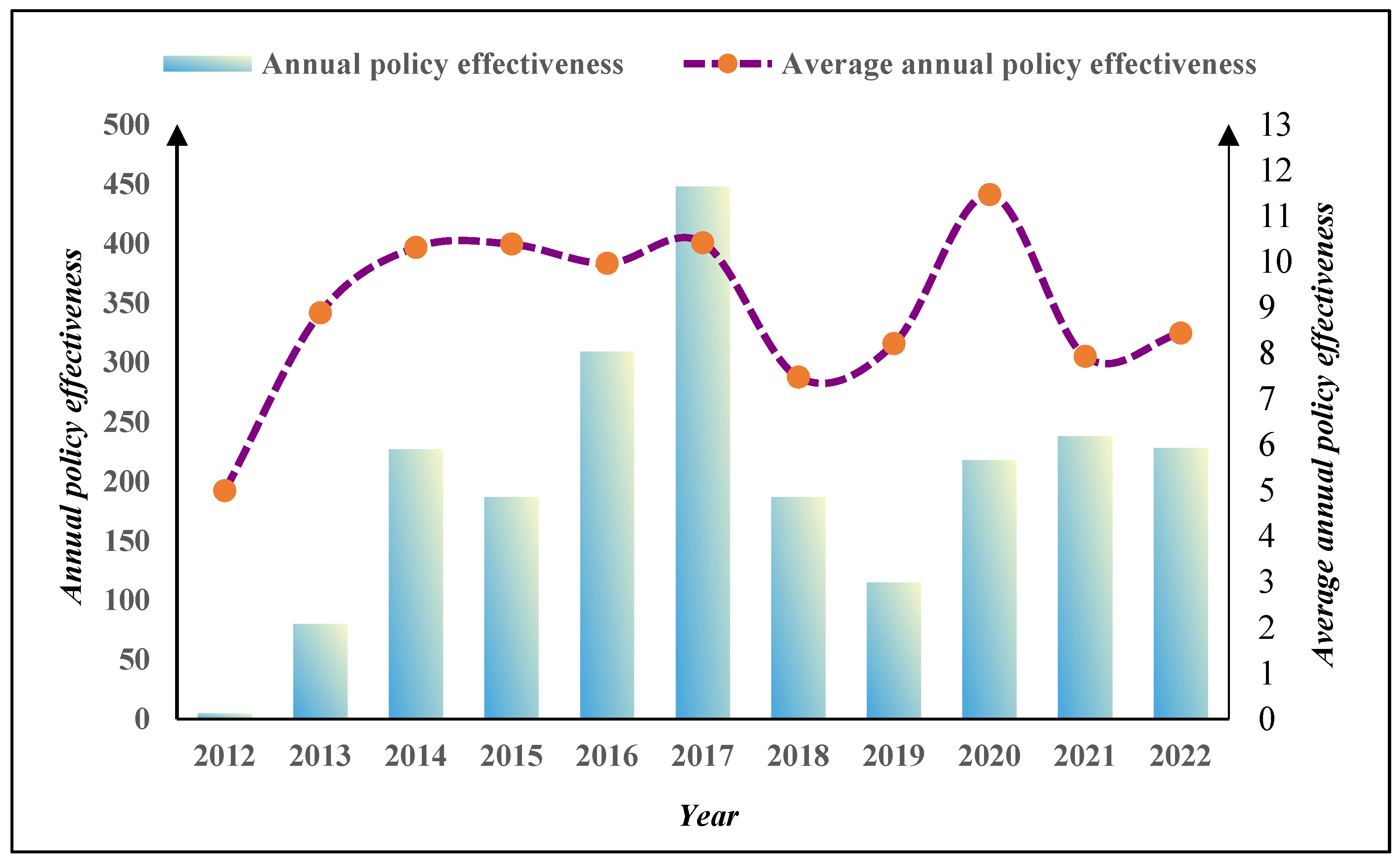

| Date | Policy Name | Content Analysis Unit | APE | Types of Policy Instruments | Name of Policy Instrument | Code |
|---|---|---|---|---|---|---|
| … | … | … | … | … | … | |
| 2014.08.27 | Circular of the National Development and Reform Commission and Eight Other Departments on the Issuance of Guiding Opinions on Promoting the Healthy Development of Smart Cities | …should seize the opportunity of smart city construction, make positive suggestions, actively participate in, and promote the construction of smart ports | 20 | Supply type Environmental type | Public service Goal programming | 2014-16 |
| … | … | … | … | … | … | |
| 2020.09.03 | Letter on supporting Wuhan to build China’s new generation artificial intelligence innovation and development pilot zone | ... accelerate the deep integration of artificial intelligence technology with smart cities and people’s livelihood | 9 | Environmental type | Goal programming | 2020-21 |
| … | … | ... | … | … | … | … |
| Category | Policy Tools | Definition |
|---|---|---|
| Supply type | Science and technology information support | The government provides public science and technology support and information services for developing a smart city by building a data database, evaluating and releasing urban construction information, and establishing oyster products. |
| Science and technology infrastructure construction | Support the opening of public information resources or build new infrastructure. | |
| Investment in science and technology | The government provides funds for R&D and construction through financial subsidies. | |
| Public service | Smart cities serve urban governance and public needs better by improving the types of public services they provide. | |
| Personnel training | Cultivate smart city talents through professional education or skills training in information technology. | |
| Environmental type | Goal programming | The policy specifies the overall objectives and requirements for the construction of smart cities. |
| Regulations and standards | The implementation of unified data formats and standardized business scenario interfaces ensures inter-connectivity between subjects, thereby enhancing the quality and efficiency of urban governance and public services. | |
| Communication and cooperation among subjects | The multi-agent communication platform and channel are built to promote communication and cooperation among multiple agents. | |
| Finance, taxation, and finance | The government promotes the construction of a smart city through loans, financing, subsidies, venture capital, financial distribution or relaxation of financial restrictions, and creation of financing conditions. | |
| Intellectual property protection | The government protects intellectual property rights related to the smart city through judicial and administrative law enforcement. | |
| Demand type | Government procurement | Priority or directional procurement of products and services catalog for smart city construction are set. |
| International communication and cooperation | Cooperation happens between overseas and foreign organizations or groups on smart city construction in various forms. | |
| Strengthening propaganda | Through policy or institutional means, the government encourages the government, enterprises, and the public to use public information resources actively to create a good atmosphere for the construction of a smart city. | |
| Demonstration project | Smart city policy pilot is set up. |
| Index | Score | Scoring Criteria |
|---|---|---|
| Policy strength P | 5 | Laws enacted by the National People’s Congress or the State Council |
| 4 | Laws and regulations issued by the State Council | |
| 3 | Policy documents or regulations and standards issued by departments under the State Council | |
| 2 | Guidance and regulations issued by agencies under the State Council ministries and commissions | |
| 1 | Circular from the ministries and committees of the State Council | |
| Policy objectives G | 5 | All of the policy’s construction goals are centered on smart cities |
| 3 | The state objectives in the policy are related to smart city construction | |
| 1 | The policy document does not set out any construction targets for smart cities | |
| Policy measures M | 5 | Starting from the overall dimension of smart city construction, detailed construction planning and implementation measures have been formulated. And the responsible units and key time nodes are clearly defined. |
| 4 | Starting from a certain aspect of smart city construction, a detailed planning arrangement is formulated, and relevant policy measures are clarified. | |
| 3 | Starting from certain aspects of smart city construction, approximate target plans are formulated, and relevant policy measures are proposed. | |
| 2 | Provide a brief implementation of the topic and a list of some fundamental steps. | |
| 1 | There is not a detailed operation plan, only from a macro-perspective. | |
| Policy feedback F | 5 | The department in charge is clear, and feedback needs to be repeated regularly |
| 3 | The department in charge is clear, but only one feedback is required. | |
| 1 | No feedback | |
| Policy supervision S | 5 | The way of supervision is clear, and the results need to be returned regularly and repeatedly. |
| 3 | The way of supervision is clear, but the supervision results are not specified or only need to be returned once. | |
| 1 | No supervision |
Disclaimer/Publisher’s Note: The statements, opinions and data contained in all publications are solely those of the individual author(s) and contributor(s) and not of MDPI and/or the editor(s). MDPI and/or the editor(s) disclaim responsibility for any injury to people or property resulting from any ideas, methods, instructions or products referred to in the content. |
© 2024 by the authors. Licensee MDPI, Basel, Switzerland. This article is an open access article distributed under the terms and conditions of the Creative Commons Attribution (CC BY) license (https://creativecommons.org/licenses/by/4.0/).
Share and Cite
Yue, C.; Li, H.; Mao, H.; Yue, A. The Evolution of Smart City Policy in China: A Quantitative Study Based on the Content of Policy Texts. Buildings 2025, 15, 7. https://doi.org/10.3390/buildings15010007
Yue C, Li H, Mao H, Yue A. The Evolution of Smart City Policy in China: A Quantitative Study Based on the Content of Policy Texts. Buildings. 2025; 15(1):7. https://doi.org/10.3390/buildings15010007
Chicago/Turabian StyleYue, Chongfeng, Hongyan Li, Haocheng Mao, and Aobo Yue. 2025. "The Evolution of Smart City Policy in China: A Quantitative Study Based on the Content of Policy Texts" Buildings 15, no. 1: 7. https://doi.org/10.3390/buildings15010007
APA StyleYue, C., Li, H., Mao, H., & Yue, A. (2025). The Evolution of Smart City Policy in China: A Quantitative Study Based on the Content of Policy Texts. Buildings, 15(1), 7. https://doi.org/10.3390/buildings15010007







